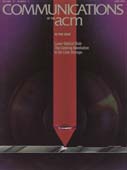June 1984 - Vol. 27 No. 6

Features
From Washington: NSF takes the initiative
The National Science Foundation's Advisory Committee for Advanced Scientific Computing Resources was formed to provide leadership for large-scale scientific computing throughout the United States. Consisting of 15 members representing universities, industry, and national laboratories, the Committee held its first meeting in January 1984. A summary of the meeting issued by Chairman Neal F. Lane of Rice University makes the following points.
Programming pearls: graphic output
In previous columns we've studied the innards of programs. In this column we'll take a broader view of the programmer's task and consider the kind of output a program should produce. We'll focus on a single problem: once a system has produced detailed output, how can it summarize the trends in the mountain of data?
The answer to that question depends heavily on both the data and the taste of the reader; paragraphs of text and tables of numbers often provide fine summaries. This column, however, will concetrate on graphical representations of data, which allow the powerful human vision system to understand data. A decade ago programmers could offer the excuse that they were limited to crude line printer graphics, but technology has changed that. Many large installations now have laser printers, and graphics printers for home computers sell for a few hundred dollars. This column is about ways that programmers can use the technology to deliver more useful (and more graphic) output.
Computer matching: should it be banned?
Since discovering the technique of computer matching several years ago, government managers have been invoking this computer tool in the attempt to root out waste and fraud in their programs. Is computer matching an indispensable tool for government administrators? Or a trampling on individual rights? In the following articles, two experts debate the pros and cons.
Laser optical disk: the coming revolution in on-line storage
Commercially available only recently, the optical disk drive uses a laser beam to burn impressions onto a plastic disk. Employing a highly focused beam rather than a diffuse magnetic field to write, the laser optical disk drive yields storage densities up to 10 times those of magnetic disks.
An assessment of the prototyping approach to information systems development
A two-phased research project comparing the prototyping approach with the more traditional life cycle approach finds that prototyping facilitates communication between users and designers during the design process. However, the findings also indicate that designers who used prototyping experienced difficulties in managing and controlling the design process.
Updating a database in an unsafe environment
Normally, when an application makes use of a database, considerable resources are invested in maintaining the integrity of that database. However, in situations where use of a database may be desirable even though the normal level of resources is unavailable, a simple technique using a partitioned data file protects the database if immediate transaction recording is not essential.
A large font virtual terminal interface: a software prosthesis for the visually impaired
A large font software interface running under UNIX1 is of great assistance to the severely visually impaired in the interactive use of computers. The interface, which functions as a virtual terminal as far as other processes are concerned, displays all characters (both user and system generated) at user-selectable degrees of magnification, yet is compatible with any standard CRT/keyboard terminal.
Talking to UNIX in English: an overview of UC
UC is a natural language help facility which advises users in using the UNIX operating system. Users can query UC about how to do things, command names and formats, online definitions of UNIX or general operating systems terminology, and debugging problems in using commands. UC is comprised of the following components: a language analyzer and generator, a context and memory model, an experimental common-sense planner, highly extensible knowledge bases on both the UNIX domain and the English language, a goal analysis component, and a system for acquisition of new knowledge through instruction in English. The language interface of UC is based on a “phrasal analysis” approach which integrates semantic, grammatical and other types of information. In addition, it includes capabilities for ellipsis resolution and reference disambiguation.
Anomalies in parallel branch-and-bound algorithms
We consider the effects of parallelizing branch-and-bound algorithms by expanding several live nodes simultaneously. It is shown that it is quite possible for a parallel branch-and-bound algorithm using n2 processors to take more time than one using n1 processors, even though n1 < n2. Furthermore, it is also possible to achieve speed-ups that are in excess of the ratio n2/n1. Experimental results with the 0/1-Knapsack and Traveling Salesman problems are also presented.



